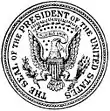Theodore Roosevelt desk
The desk in the Vice President’s Ceremonial Office in the Eisenhower Executive Office Building, colloquially known as the Theodore Roosevelt desk, is a large mahogany pedestal desk in the collection of the White House. It is the first of six desks to have been used by U.S. presidents in the Oval Office.
.jpg.webp) The Theodore Roosevelt desk in the Oval office during Harry S. Truman's presidency | |
| Designer | Charles Follen McKim |
|---|---|
| Date | 1903 |
| Made in | Boston, Massachusetts by A. H. Davenport and Company |
| Materials | Mahogany |
| Style / tradition | Colonial Revival |
| Height | 30 in (76 cm) |
| Width | 90 in (230 cm) |
| Depth | 53.5 in (136 cm) |
Made in 1903 for the newly constructed Executive Office Building, now the West Wing, the mahogany desk was one of several pieces of furniture made specifically for the building. The desk survived a major fire in the West Wing December 24, 1929, and was placed in storage for over a decade. The desk was subsequently used by Harry S. Truman and Dwight D. Eisenhower in the Oval Office after the Wilson desk, its Oval Office replacement, was given to Eleanor Roosevelt after Franklin D. Roosevelt's death. After briefly using the Theodore Roosevelt desk in the Oval Office, John F. Kennedy switched to the Resolute desk and moved the Theodore Roosevelt Desk to the Vice President’s Ceremonial Office in the Eisenhower Executive Office Building. Richard Nixon used this desk in his "working office" in the Eisenhower Executive Office Building, where some of the Watergate tapes were recorded by microphones attached to it. After Nixon resigned, the Theodore Roosevelt desk was moved back to the Vice President’s Ceremonial Office where it has been used by every Vice President since. Many of its past users have signed the inside of its center drawer.
Design and markings
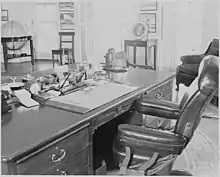
The Theodore Roosevelt desk is a mahogany pedestal desk and is owned by the White House.[1][2] The 30 in (76 cm) high desk has a workspace which measures 90 in (230 cm) wide and 53.5 in (136 cm) deep.[1] The understated design is marked by elegant and masculine lines and is detailed with brass pulls.[2] There are two alterations to the desk that took place during the Nixon administration. A hole was drilled in the desk top so phone cords could be threaded through the desk out of sight, and a lock was placed on the left hand drawer to secure a recording device located there.[3] The desk was described in a 1949 article in Parade Magazine as being "...time-worn, fire-scarred, [and] repainted...".[4]
The desk was built and designed as part a full refresh of the furnishings of the White House where all old furniture was replaced with new pieces.[5] This refurnishing was done with the stated aim to "...design and furnish the interior in harmony with its neoclassical exterior architecture, in order that it would not be subject to changing fashion."[6] These new furnishings were part of a widespread attempt at the time to develop a national design identity which had been growing since the Philadelphia Centennial Exposition. Betty C. Monkman explained through the White House Historical Association that at this time, "Americans looked back to the nation’s origins and an idealized past and sought representative antiques or reproductions of furnishings from the earliest periods of the country’s history. Colonial Revival furnishings and copies of English and French neoclassical styles were selected for rooms at the same time that a growing emphasis on lighter spaces and a reaction away from pattern in wallpaper, fabrics, and carpets—and from a certain busyness and "artistic" clutter in the number and arrangement of objects—were changing American interiors."[5] A pamphlet explaining the renovations of the White house from the time claimed that before this new set of furniture was purchased the furnishing in the White House there was "an inequality in the furniture of the whole house (owing to the unwillingness and piecemeal manner with which Congress votes any moneys for its decoration) which destroys its effect as a comfortable dwelling."[7] The pamphlet continued extolling the new furniture and interiors with, "It is to be hoped that Congress will not always consider the furniture of the President's House as the scapegoat of all sumptuary and aristocratic sins, and that we shall soon be able to introduce strangers not only to a comfortable and well-appointed, but to a properly served and nicely kept, Presidential Mansion."[7]
Beginning in the 1940s, each user of the desk signed the interior of the center drawer at the end of his term in office.[8] In 1974 it was noted in a memo that the signatures of Truman, Eisenhower, and Johnson (as well as Truman and Eisenhower's initials) were located in this drawer.[1] Since then the drawer has been signed by vice presidents Nelson Rockefeller, Walter Mondale, George H. W. Bush, Dan Quayle, Al Gore, Dick Cheney, Joe Biden, and Mike Pence.[9][10]
History
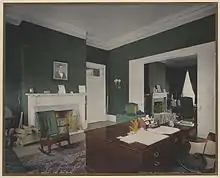
In 1901 Theodore Roosevelt became President of the United States following the assassination of William McKinley. Upon moving into the White House the Roosevelts found the Victorian interiors crowded and dingy and generally too small for their large family.[6][11] A major renovation of the White House was undertaken 1902 to remove this Victoriana and otherwise bring the building to modern standards. Roosevelt's wife, Edith Roosevelt worked with Charles Follen McKim, of McKim, Mead, and White, to achieve this renovation including the separation of the working offices from the living quarters.[12][13][11] Part of this renovation was the construction of the Executive Office Building, now known as the West Wing, where a series of greenhouses stood.[13][14] This building was originally designed to be a temporary structure but was later asked by Congress to be built to later support a second story.[13][15] It was designed to contain separate rooms for files, stenographers, telegraph and telephone, a press room, a cabinet room, a reception room, two secretary offices, and a "president's office and retiring room."[15] Planning for the interiors began in earnest in 1902 for the executive offices, state rooms, and family spaces. Because of delays in fund appropriation from congress for the project had less than 6 months for the interiors to be designed, built, and installed as the spaces needed to be ready for the social season over the winter of 1903.[5] Mrs. Roosevelt was incredibly hands on with the redesign of the White House and new office building with all fabrics and furniture having to be approved by her.[6] Construction began on June 20, 1902,[16] The budget for all of the furniture in this building was $10,000 with a total of $14,054.77 actually being spent on "furniture, carpets, rugs, electric lighting and other fixtures".[16] The entire Executive Office Building was designed by McKim, Mead, and White, including the "heating apparatus and light, fixtures, furniture, and removal of greenhouses."[14] Construction wrapped up on this building September 29, 1902, with occupation beginning in the middle of October.[17]
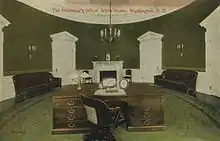
The desk, as well as all other furniture in the Executive Office Building, now West Wing, was designed by McKim and built by furniture-maker A. H. Davenport and Company in Boston, Massachusetts in 1903.[1][14][18][11] Davenport worked closely with McKim to create furniture that worked within their concept and may have even contributed design ideas as well.[6] This first desk in the West Wing was used by Roosevelt in his Executive Office in the location where the Roosevelt Room is found in the contemporary West Wing.[19][20]
Roosevelt's successor, President William Howard Taft, expanded the Executive Office Building further and added its first Oval Office.[11] He moved the Theodore Roosevelt desk into the new space, called the "President's Office" or "Executive Office" at the time, and paired it with dyed green burlap wall coverings, brass light fixtures, and additional mahogany furniture.[21] The desk was the first one to be used in the Oval Office, remained in the room for twenty years, and was used by Presidents Woodrow Wilson, Warren G. Harding, Calvin Coolidge, and Herbert Hoover.[20][1] Hoover notably had the first telephone installed in the Oval Office on this desk on March 29, 1929.[22]
The West Wing suffered a major fire on December 24, 1929, Christmas Eve, during Herbert Hoover's presidency. This four-alarm fire was the most destructive to strike the White House since the Burning of Washington 115 years earlier. One hundred thirty firefighters over nineteen engine companies and four truck companies were needed to extinguish the blaze. Caused either by a faulty or blocked chimney flue or defective wiring, the fire began in the attic of the building where an estimate 200,000 government pamphlets were stored and ignited.[23] Many of the important documents in the area were recently moved to the Library of Congress following a minor remodel of the building.[24] The fire was noticed at approximately 8:00 pm by White House messenger Charlie Williamson, and immediate action was taken to save items in the building. Chief Usher Ike Hoover, the president’s son Allan Hoover, the president's personal secretaries Lawrence Richey and George Akerson, and some Secret Service agents crawled into the building through a window just to the left of the Theodore Roosevelt desk.[24] The first things they saved were current papers, followed by completely clearing the top of the desk and removing the drawers which were passed through the windows to safety.[25] They then began removing steel cabinets full of files, the chair at the president's desk, and the presidential flag.[23] They later also saved the chairs the Cabinet used at cabinet meetings and more documents. All of these valuable objects and papers, including the Roosevelt desk drawers, were left on the White House Lawn and guarded all night by 150 infantrymen from the local Washington barracks.[24] Akerson later stated that all historically and sentimentally valuable items in the president's office were saved.[25]

While the desk drawers and their contents had been moved safely out of the building, the main body of the desk was still at risk, especially to water damage from the fire hoses on the freezing cold night. Ike Hoover acquired the tarpaulin awning that covered the White House's east entrance for the upcoming New Years Day reception and used it cover and protect the desk. The fire was put out by approximately 10:30 pm leaving the executive offices, roof, attic, and floors heavily damaged and the press room completely ruined.[23] After the fire Hoover immediately started using the White House's Lincoln Study to conduct business in and after a few days moved his official offices to what is now the Vice President’s Ceremonial Office in the Eisenhower Executive Building.[25] No insurance had been taken out on the White House so a special appropriation from Congress had to be made to repair the building. A contract was awarded on January 4, 1930 to Charles H. Tompkins Co. to do the repair work and it was completed on April 14th of the same year.[23] The new Oval Office was built slightly larger and in the Colonial Revival style.[11] [26]
The desk survived this fire and was later fully repaired. A duplicate of the desk was made at this time and both desks were placed in storage.[1][8] The original Theodore Roosevelt desk remained in storage from December 1929 to 1945.[8] An association of Grand Rapids, Michigan furniture-makers built a new suite of 17 furniture pieces in 1930 as a gift for the rebuilt Oval Office including a new desk, now known as the Hoover desk.[26] This desk was used by President Hoover for the remainder of his time in office and for all of Franklin D. Roosevelt's tenure. After Franklin Roosevelt's death this desk was given to his wife, Eleanor Roosevelt by then president Harry S. Truman.[27] The Theodore Roosevelt desk was brought back to the Newly Rebuilt Oval Office at this point and was used by Truman, who placed a sign reading "The Buck Stops Here" on it, as well as Dwight Eisenhower.[1][28] It was also briefly used by John F. Kennedy before it was switched out in 1961 for the Resolute desk by his wife, Jacqueline Kennedy, who thought the more ornately carved furniture piece should be the most visible presidential desk.[29]
At this point the desk was moved to the Vice President’s Ceremonial Office in what is now called the Eisenhower Executive Office Building and began being used by Vice President Lyndon Johnson there. The desk has remained there since and used by all vice president in this room, with the exception of Hubert Humphrey.[30] Following the 1963 assassination of John F. Kennedy, Lyndon Johnson did not vacate the Vice President's Ceremonial Office. He chose to continue using room 274 as his working office out of respect for Kennedy, leaving Humphrey to work out of room 180 in the same building.[3]
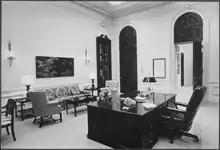
When President Richard Nixon ascended to the presidency in 1969 he decided to use the Oval Office as a ceremonial office and turned room 180 of the Old Executive Office Building into his "working office" for the duration of his presidency.[3] As part of a larger installation of microphones across the president's spaces in the White House and associated buildings, four microphones were installed in the Theodore Roosevelt desk in April 1971. Three microphones were attached to the edges of the desk and one was placed in the open knee hole.[31] The microphones were wired to an adjoining room where an audio mixer and sound recorder were housed. The telephone in this room was also tapped as part of a separate recording system.[31][32] As part of this installation a hole was drilled in the desktop to feed phone cables through and a recording apparatus was concealed in the left hand drawer of the desk. A lock was installed on this drawer to keep the device hidden.[3] Some of the Watergate tapes were made by these recording devices.[20][3] The entire tapings system was removed on July 18, 1973 at the orders of Alexander Haig, Nixon's Chief of Staff due to its existence being made public during testimony before the Senate Watergate Committee two days before.[32] A total of 204 recordings were made with these microphones while the system was in existence.[31]
The desk was moved back to the Vice President's Ceremonial office following Nixon's resignation where it has remained since, being used by all subsequent vice presidents. A tradition rose where each vice president signs the interior of the center drawer at the end of their time in office. Every vice president since Nelson Rockefeller has signed it, and signatures of presidents Truman, Eisenhower, and Johnson are also found in the drawer.[8][9]
In 2007 a two-alarm fire broke out in the Eisenhower Executive Office centered on an electrical closet or telephone room near the Vice President’s Ceremonial Office. There were no serious injuries. It is unclear if the desk suffered any damage but the office suffered smoke and water damage with the floors notably being "under water."[33]
Timeline
The following table traces the location and tenants of the Theodore Roosevelt Desk from its 1902 installation in the Executive Office Building through the present. Each tenant of the desk is listed with the dates and location where they used the desk.
| Tenant | Location | Dates | Ref. |
|---|---|---|---|
| Theodore Roosevelt | White House Executive Office | 1902–1909 | [18] |
| William Howard Taft | Oval Office White House |
1909–1929 | [18] |
| Woodrow Wilson | |||
| Warren G. Harding | |||
| Calvin Coolidge | |||
| Herbert Hoover | |||
| Storage | 1929–1945 | [8] | |
| Harry S. Truman | Oval Office White House |
1945–1961 | [1] |
| Dwight D. Eisenhower | |||
| Lyndon B. Johnson | Vice President's Ceremonial Office Eisenhower Executive Office Building |
1961–1969 | [30] |
| Richard Nixon | Room 180 Eisenhower Executive Office Building |
1969–1974 | [20] |
| Nelson Rockefeller | Vice President's Ceremonial Office Eisenhower Executive Office Building |
1974–present | [8] |
| Walter Mondale | |||
| George H. W. Bush | |||
| Dan Quayle | |||
| Al Gore | |||
| Dick Cheney | |||
| Joe Biden | |||
| Mike Pence | |||
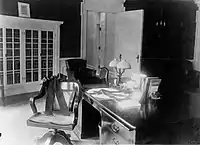 The desk and Warren G. Harding's chair with mourning crepe, on August 8, 1923, the day of his funeral.
The desk and Warren G. Harding's chair with mourning crepe, on August 8, 1923, the day of his funeral.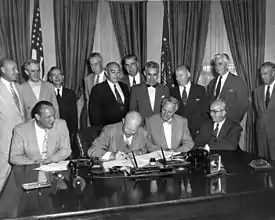 President Eisenhower signing H.R. 9757, an act "to amend the Atomic Energy Act of 1946", on the Theodore Roosevelt Desk on August 30, 1954
President Eisenhower signing H.R. 9757, an act "to amend the Atomic Energy Act of 1946", on the Theodore Roosevelt Desk on August 30, 1954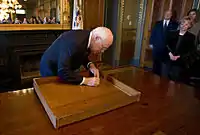 Vice President Cheney signing the desk drawer near the end of his term in office, January 12, 2009
Vice President Cheney signing the desk drawer near the end of his term in office, January 12, 2009
Replicas
A replica of the Theodore Roosevelt desk is located in the Harry S. Truman Presidential Library and Museum, in Independence, Missouri, as a part of a full-scale replica of the Oval Office furnished as it was during Truman's presidency. The objects on the desk are both original and reproductions of objects as seen in a series of images taken in August 1950 of the empty office.[34] A second replica of the desk is in White House Storage. This duplicate was constructed between 1929 and 1930 after the original desk was damaged in the 1929 Christmas Eve West Wing fire.[1]
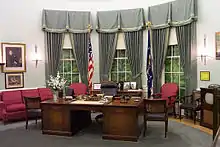
References
- "Memo, Frank Pagnotta to Robert Hartmann" Gerald R. Ford Presidential Library. Gerald R. Ford Presidential Handwriting File, retrieved January 25, 2017
- Serratore , Angela. The presidential desk: A brief history. Curbed. November 8, 2016. Retrieved December 6, 2020.
- Room 180. George W Bush whitehouse.gov archives. Retrieved December 3, 2020.
- The President's Desk. Parade magazine. May 22, 1949. Retrieved December 5, 2020.
- Monkman, Betty C. The White House Collection: The Beaux Arts Furnishing of 1902. White House Historical Association. Retrieved December 4, 2020
- WHITE HOUSE. An archive of drawings and blue prints from Davenport Co. and McKim, Mead & White, 1902. Christie's. December 3, 2007. Retrieved December 4, 2020.
- Restoration. pp. 45–46.
- Vice President's Ceremonial Office. George W Bush whitehouse.gov archives. Retrieved December 3, 2020.
- Liptak, Kevin. Biden signs desk in farewell tradition. CNN. January 6, 2017. Retrieved December 4, 2020.
- Linge, Mary Kay. "Pence says to 'hold your heads high' in emotional meeting with staffers". New York Post. January 9, 2021. Retrieved January 9, 2020.
- The East and West Wings of the White House: history in architecture and building. White House Historical Association. Retrieved December 4, 2020.
- Roosevelt, Edith Kermit Carow. Theodore Roosevelt Center. Dickinson State University. Retrieved December 4, 2020
- The White House Building. White House. Retrieved December 4, 2020.
- Restoration. p. 7.
- Restoration. p. 11.
- Restoration. pp. 11–13
- Restoration. p. 13.
- The President's Office, Theodore Roosevelt Administration. White House Historical Association. Retrieved December 4, 2020
- Tour the West Wing. Barack Obama whitehouse.gov archives. Retrieved December 4, 2020.
- Hess, Stephen. "What Now? The Oval Office". Brookings Institution. January 8, 2009. Retrieved December 4, 2020.
- Postcard view of the Oval Office. White House Historical Association. Retrieved December 4, 2020
- Herbert Hoover has telephone installed in Oval Office. History. March 26, 2020. Retrieved December 6, 2020.
- Treese, Joel D. Phifer, Evan. The Christmas Eve West Wing Fire of 1929. White House Historical Association. Retrieved June 4, 2020
- "Fire Wrecks The White House Offices; Hoover Rushes from Party to Watch it; Aides Brave Smoke to save his papers". The New York Times. December 25, 1929. Retrieved December 5, 2020.
- "President Chooses White House Study for Use as Office". The New York Times. December 26, 1929. Retrieved December 5, 2020.
- President Hoover's Executive Office Suite. Grand Rapids Historical Commission. Grand Rapids Spectator. June 28, 1930. Retrieved December 5, 2020
- Artifact Highlight: FDR’s Oval Office Desk. Franklin D. Roosevelt Presidential Library and Museum. May 27, 2020. Retrieved December 5, 2020.
- "The Buck Stops Here" Desk sign. Harry S. Truman Presidential Library and Museum. Retrieved December 5, 2020.
- Mrs. Kennedy's decision to move the Resolute Desk into the Oval Office. John F. Kennedy Presidential Library and Museum. March 27, 2020. Retrieved December 5, 2020.
- The Vice President's Ceremonial Office. Virtual Tour of the Eisenhower Executive office Building. Google Arts and Culture. Retrieved December 4, 2020
- Nixon Secret White House Recordings: Collection Specifications. Miller Center of Public Affairs. University of Virginia. Retrieved December 5, 2020.
- History of the White House Tapes. Archived October 15, 2011, at the Wayback Machine. Richard Nixon Presidential Library. Retrieved December 5, 2020
- Stolberg, Sheryl Gay. "Fire Breaks Out on White House Grounds". The New York Times. December 20, 2007. Retrieved December 4, 2020.
- Davenport, Jerry. President Truman's Desk. Harry S. Truman Presidential Library and Museum. Retrieved December 5, 2020
Bibliography
- Restoration of the White House: Message of the President of the United States Transmitting the Report of the Architects. Washington, D.C.: Government Printing Office, 1903. Retrieved December 4, 2020.
External links
 Media related to Theodore Roosevelt desk at Wikimedia Commons
Media related to Theodore Roosevelt desk at Wikimedia Commons

